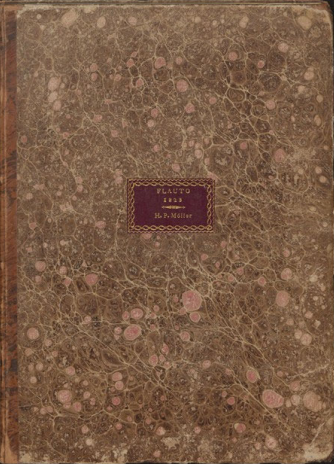
H.P. Møllers stemmebøger
– for English see below
H. P. Møllers stemmebøger er en skat fra den danske guldalder. En nodesamling som var glemt, men blev fundet på Det kgl. Bibliotek i 2014 af Toke Lund Christiansen. Nodebøgerne indeholder, udover tidens danse, den mest populære musik fra Det kgl. Teater fra 1800-tallets første tre årtier. Det er operaarier og -ouverturer, som i tiden er arrangeret for fløjte, to violiner og cello. Det var helt i tidens ånd at bruge musikken ved at arrangere orkesterværker ned til et ”mobilt ensemble”. På den måde kunne orkestermusik fylde hjemmene, og en magtfuld konge som Frederik VI kunne på én og samme tid både byde på tidens mest populære toner og byde op til dans.
”Frederik VI’s hofensemble” har indspillet musikken for at bevare de originale fløjters klang og for at vise, hvordan det var sædvane at bruge musikken i 1800-tallet.
CD’en kan bestilles herunder
A treasure from the Danish Golden Age – The part books of H. P. Møller
The H.P. Møller’s part books include primarily arrangements of ouvertures and arias from the most popular operas from the first 25 years of the 19th Century. We probably all know most of the recorded music – we just know it for a full orchestra. Although the vast majority of the arrangements in H.P. Møller’s part books are very well composed and a solid piece of work, there will be a lack of parts, harmonies and power. It is a fact. With that in mind, this was the way music was used in the 19th century, and it was also in such arrangements that the King and everyone else heard the music again. You could almost measure the popularity of a symphony or opera by the number of arrangements.
I have insisted recording these arrangements since it is a part of our cultural heritage. It is a collection of music that shows the rich musical life of our predecessors, and it has been my wish to make it accessible to a wider circle. The intention has thus not been to come up with exciting new interpretations of the works we all know so well, but to adapt the interpretations to the ensemble and at the same time spread awareness of the treasure that H.P. Møller’s part books have proved to be.
At the same time, it has been my intention to get as close to a credible sound as possible, and I believe that I have achieved this by playing on the three flutes I do. The instruments are over 200 years old, and for this project they have been played into a good condition. It has been important to me to preserve this sound, which is another reason for this recording, and why I have put in countless hours playing in, caring for and nurturing the flutes. Modern copies of all these flutes can easily be made, but the original flutes simply have a depth of tone and resonance that cannot be duplicated.
The flutes
The flutes I play in the present recording are all three original instruments that could have played this repertoire at the time. The music from the operas is played on an original four-keyed Grenser ebony flute. Kolbe’s Romanza Siciliana is played on a Skousboe boxwood flute with two keys, and finally a four-keyed boxwood H.C. Hansen tierce flute is played on, where one is required. The flutes of Skousboe and H. C. Hansen have been restored and lend by flute maker and collector Bo Karberg and the Grenser-flute was lend to me by Toke Lund Christiansen.